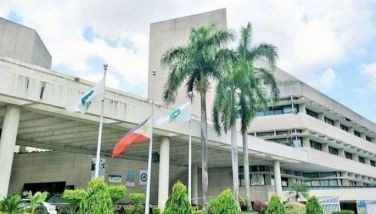Killer quake: More than 90 dead in Visayas
MANILA, Philippines - A powerful earthquake with a force reportedly equivalent to atomic bombs killed more than 90 people in Bohol, Cebu and Siquijor yesterday as it tore down modern buildings and historic churches and triggered stampedes.
As of press time, 15 of the confirmed fatalities were in Cebu City, disaster officials said.
Related: Visayas quake devastation by the numbers (updated)
The quake killed another 77 people in the neighboring island of Bohol, famed for its rolling Chocolate Hills and Spanish-era churches, while one person died on nearby Siquijor island.
The Philippine Institute of Volcanology and Seismology (Phivolcs) said the quake, which struck at 8:12 a.m., was measured at magnitude 7.2 and its epicenter was traced some two kilometers southeast of Carmen, Bohol.
The US Geological Survey measured the quake at magnitude 7.1.
“I was thrown to the ground by the strength of the quake. Broken glass rained on me,†said Elmo Alinsunorin, a guard for a government tax office in Cebu. “I thought I was going to die.â€
Authorities said the death toll could still climb, with authorities struggling to assess the extent of the damage in the worst hit areas of Bohol where roads were impassable and power was cut.
Nevertheless, they expressed relief the earthquake occurred on a public holiday, when there were fewer people than normal in many of the major buildings that suffered damage.
In Cebu City, the quake caused the roof of a fish port and a market to collapse, killing four people.
The quake set off a stampede in a Cebu gym where people had lined up to receive government cash assistance, killing five and injuring eight others, said Neil Sanchez, provincial disaster management officer.
“We ran out of the building, and outside, we hugged trees because the tremors were so strong,†said Vilma Yorong, a Bohol provincial government employee.
“When the shaking stopped, I ran to the street and there I saw several injured people. Some were saying their church has collapsed,†she said.
As fear set in, Yorong and others ran up a mountain, afraid a tsunami would follow the quake. “Minutes after the earthquake, people were pushing each other to go up the hill,†she said. But the quake was centered inland and did not cause a tsunami.
Holiday saved lives
Offices and schools were closed for a national holiday – the Muslim festival of Eid’l Adha – which may have saved lives.
“I was fast sleep when suddenly I woke up because my bed was shaking. I was so shocked, I could do nothing but hide under the bed,†Janet Maribao, 33, a receptionist in Cebu, said.
“I was so scared, I could not even run out of the house. It was only 30 minutes later that we were able to leave the house,†she said.
Aledel Cuizon, who works for a Finnish company in Cebu, said the quake that caught her in her bedroom sounded like “a huge truck that was approaching and the rumbling sound grew louder as it got closer.â€
She and her neighbors ran outside where she saw “the electric concrete poles were swaying like coconut trees.†She said it lasted 15-20 seconds.
Cebu City’s hospitals quickly evacuated patients to the streets, basketball courts and parks.
In the immediate aftermath of the quake, authorities were struggling to reach or contact damaged areas, with power lines as well as phone networks down, and a full picture of the disaster had yet to emerge.
“Communication lines are quite difficult here,†Neil Sanchez, head of the Cebu disaster management office, told ABC-CBN television.
“Even the disaster risk reduction management office has been damaged. We had to move elsewhere,†he said.
Cebu province, about 570 kilometers from Manila, has a population of more than 2.6 million people. Bohol has 1.2 million people and is popular among foreigners because of its beach and island resorts and the Chocolate Hills.
Many roads and bridges were reported damaged, but historic churches, dating from the Spanish colonial period, suffered the most. Among them is the 16th-century Basilica of the Holy Child in Cebu, which lost its bell tower.
A 17th-century limestone church in Loboc town, southwest of Carmen, crumbled to pieces, with nearly half of it reduced to rubble, according to Robert Michael Poole, a British tourist who was visiting the area.
“It's absolutely devastated... the entire front of the church has collapsed onto the street,†Poole said.
However, he said there was nobody in the church at the time of the quake.
There were no reports of foreign tourists killed or injured anywhere in the disaster zone.
Regional military commander Lt. Gen. Roy Deveraturda said that he recalled soldiers from holiday furlough to respond to the quake. He said it damaged the pier in Tagbilaran, Bohol’s provincial capital, and caused some cracks at Cebu’s international airport but that navy ships and air force planes could use alternative ports to help out.
Warning out
Phivolcs director Renato Solidum said the tremor, which lasted for about 30 seconds, was tectonic in origin.
“We have mapped this fault (East Bohol Fault) and we have conducted an information campaign, warning the people of the possibility of Intensity 7 and 8 earthquakes in the area,†Solidum said.
Solidum advised people in affected areas to inspect damage in their houses or buildings before they reoccupy them as aftershocks could last for weeks or months.
“We expect aftershocks to diminish in the coming days,†Solidum said.
Phivolcs and the Pacific Tsunami Warning Center in Hawaii said there was no threat of a Pacific-wide tsunami after the quake. “The quake struck on land and there was no danger of a tsunami,†Solidum said.
The quake was felt at Intensity 7 in Tagbilaran, Bohol; Intensity 6 in Inigaran, Negros Occidental; Intensity 5 in Iloilo City and La Carlota, Negros Occidental; Intensity 4 in Masbate City, Roxas City, San Jose, Culasi, Antique; and Guihulngan, Negros Oriental and Intensity 3 in Davao City.
Intensity is defined by Phivolcs as the strength of seismic shaking while magnitude is the measurement of energy released by an earthquake.
Solidum said this was the strongest quake recorded in the province in the past two decades.
Solidum said the quake’s force was equivalent to 32 atomic bombs dropped on Hiroshima in the closing days of World War II. He said the Bohol tremor is within the category of a “major†earthquake because of its magnitude. As of 5 p.m., 289 aftershocks have been recorded.
Solidum said earthquakes of magnitudes 5.6 and 6.8 hit Bohol in 1996 and 1990, respectively.
He also advised Manila residents to be prepared, saying the city has historically been earthquake prone. He said old churches in the city bore marks of past earthquakes they had withstood.
“That’s a very historical proof that Metro Manila has been affected by earthquakes in the past and because this place has been affected by earthquakes in the past, it can be affected in the future,†he told reporters in a briefing.
National Disaster Risk Reduction and Management Council (NDRRMC) chairman and Defense Secretary Voltaire Gazmin and heads of attached agencies had a closed door meeting with President Aquino at Camp Aguinaldo to map out disaster response strategies.
“Had this quake happened during Sunday, it would have been a different story,†Gazmin said in a press briefing.
State of calamity
Cebu and Bohol, meanwhile, have been declared under a state of calamity.
“The provincial board of Cebu during a special session passed a resolution placing the entire province of Cebu under state of calamity,†said Cebu Gov. Hilario Davide III yesterday.
He said this would allow the provincial government to speed up operations to assist those affected by the earthquake.
The governor also said he had instructed the provincial engineering office to immediately conduct assessment on the structural integrity of buildings in the province.
“I have signed an order earlier suspending all classes in all levels in the province,†he added.
“The provincial board of Bohol held a special session to declare the province under state of calamity to allow the local government to use their calamity funds in response to the situation in their respective localities,†Bohol Gov. Edgar Chato said. “We got (a) report from the PNP (Philippine National Police) that 25 people were dead, 104 injured.â€
Minda Morante of the Bohol Provincial Disaster Risk Reduction Management Council said the earthquake injured more that 200 people in the province.
“Baclayon Church was 80 percent damaged, and also the Loboc Church and several school buildings were also damaged. Two bridges in Bohol are not passable,†Morante said in a television interview.
“We need to inspect the integrity of the buildings,†she said, citing cracks detected in some buildings.
“Power interruption occurred but was immediately restored,†she said.
Australian Ambassador Bill Tweddell issued a statement yesterday extending his government’s “heartfelt sympathies for the loss of lives and destruction resulting from this devastating earthquake.†“The Australian government is working with our partners, including in the Philippine government, to obtain more information on the extent of damage caused.â€
The Philippines lies on the so-called Pacific Ring of Fire, a chain of islands that are prone to quakes and volcanic eruptions.
More than 100 people were left dead or missing in February last year after an earthquake struck Negros province, about 100 kilometers from the epicenter of yesterday’s quake. The earthquake was also deeper below the surface than the 6.9-magnitude temblor last year in waters near Negros.
The deadliest recorded natural disaster in the Philippines occurred in 1976, when a tsunami, triggered by a magnitude 7.9 earthquake, devastated the Moro Gulf in Mindanao killing 5,000 to 8,000 people. With Cecille Suerte Felipe, Alexis Romero, Ricky Bautista, Freeman News Service, AP
- Latest
- Trending































